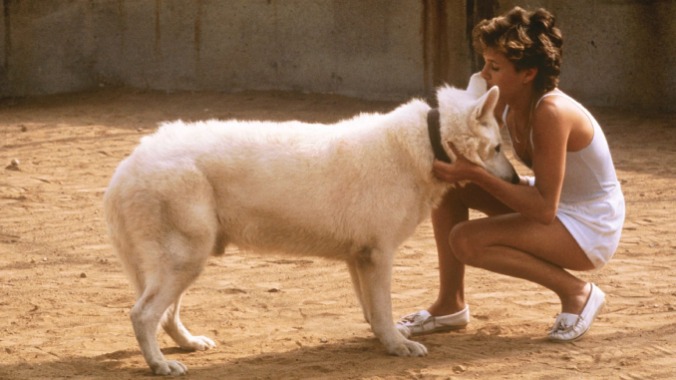Film School: White Dog
Subscriber Exclusive

Welcome to Film School! This is a column focused on movie history and all the stars, filmmakers, events, laws and, yes, movies that helped write it. Film School is a place to learn—no homework required.
In 1975, Paramount Pictures bought White Dog from French author Romain Gary. The bestselling novel told the story of a dog trained by a racist to kill Black people, and a Black trainer’s efforts to reprogram it. Complex and incendiary, the project rattled through numerous directors and producers on its way towards fruition. Years passed.
By the time 1981 rolled around, talk of a looming writer’s strike was making Paramount nervous. They needed projects that were developed enough to be made quickly, and the languishing White Dog was pushed to the top of the pile. Curtis Hanson, who’d been attached to the project for years, suggested Sam Fuller as a potential director; he had a track record for efficiency, and for dealing with racial issues, and the success of The Big Red One had made him a name again, after many years. Fuller rapidly signed up, and he and Hanson got to work on their screenplay.
Driving home one night, struggling actress Julie (Kristy McNichol) accidentally runs over a dog. She takes it to the vet and pays for its medical treatment, then decides to keep it at her L.A. home while she tries to find its owner. After the dog saves her from an intruder, gratitude leads her to form a profound bond with the creature that has fallen into her life.
But then, entirely unprovoked, the dog attacks a Black actress friend of Julie’s, causing her serious harm. After another unprovoked attack, it becomes apparent that the dog’s previous owner was a racist who trained it to kill Black people. Hoping to avoid putting it down if at all possible, Julie takes the dog to Keys (Paul Winfield), an animal trainer—and a Black man—in the hopes he can reprogram it. Keys and Julie are all too aware that, if he fails, there are many more lives on the line than just the dog’s.
Though Fuller spanned multiple genres over the course of his filmmaking career, White Dog was the closest he came to an out-and-out horror movie. The dog, a white German Shepherd, is given both a mythic air and a disconcerting interiority by Fuller’s typically robust camera—and of course, blood looks disturbingly striking against the dog’s bright white coat. While the genre was new ground for him, the sensational nature of the narrative certainly suited Fuller’s balls-to-the-wall style to a tee.
And yet his message is inescapably bleak. The final scene sees Keys succeed in his mission to deprogram the dog. But just as he, Julie and Keys’ colleague Carruthers (Burl Ives) are celebrating, the dog turns tail and mauls Carruthers—who is white—to death.
-

-

-

-

-

-

-

-

-

-

-

-

-

-

-

-

-

-

-

-

-

-

-

-

-

-

-

-

-

-

-

-

-

-

-

-

-

-

-

-








































